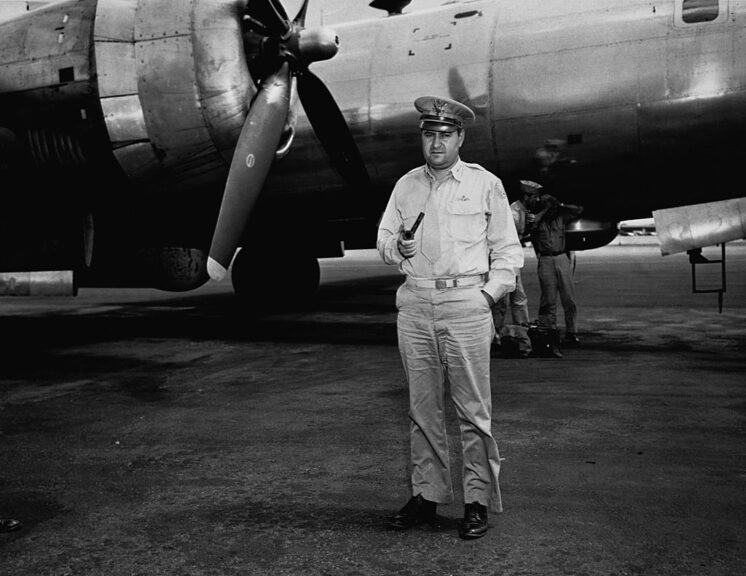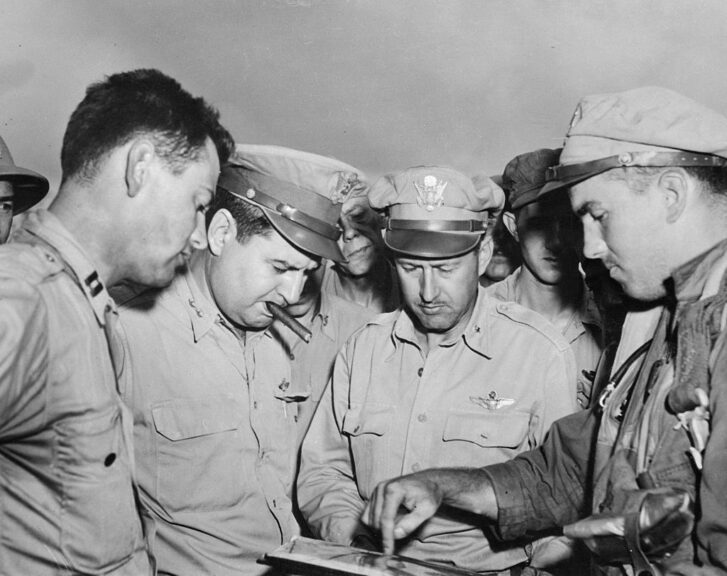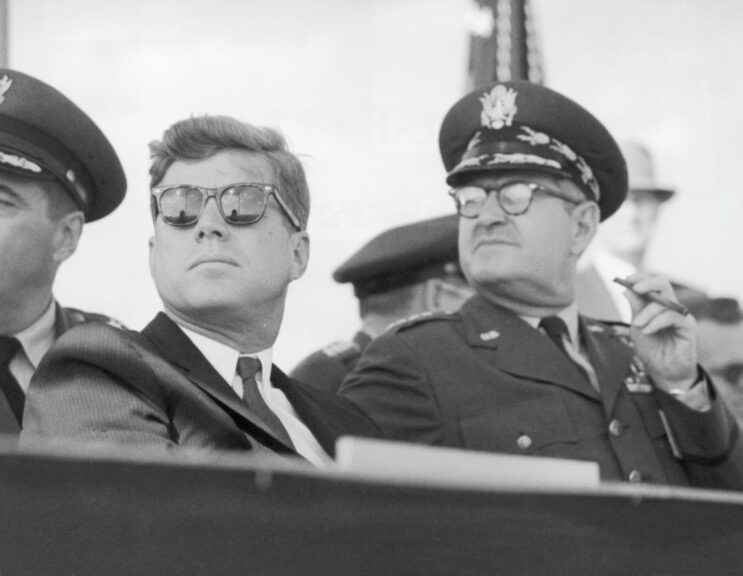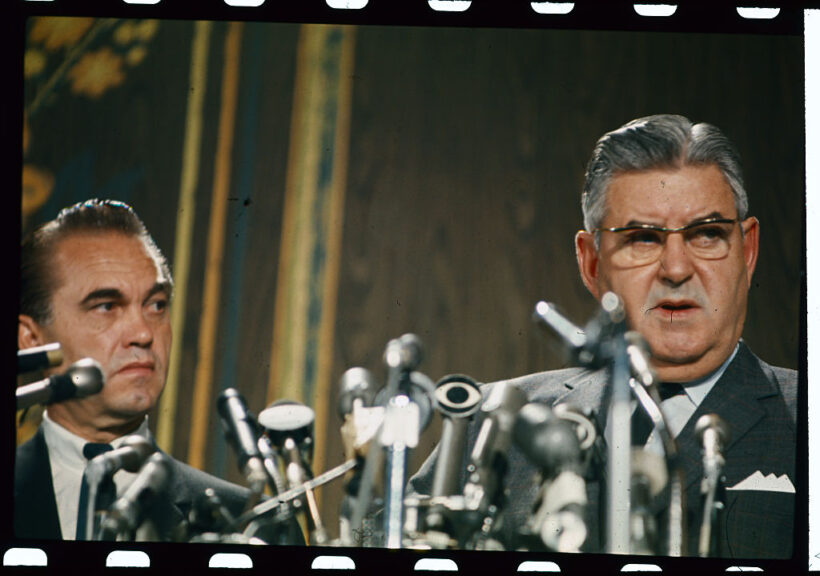Over the years, the United States has produced many remarkable generals and admirals, but only a few have stood out as world-class strategists and leaders of troops. As Veterans Day approaches on November 11, let’s remember and celebrate them. Here is my list of America’s finest 11 commanders.
Curtis E. LeMay, 1906 – 1990 (World War II)
Cold, calculating, and brutally efficient, few American commanders have so understood not just the power of a weapon at his disposal, but the proper way to deploy it to the most effect as did Air Force Major General Curtis LeMay. The weapon was the strategic bomber.
As commander of the USAAF 305th Bombardment Group in Europe, then-Col. LeMay was once faced with a problem of crews prematurely aborting their missions. He figured it had to do with will more than anything else. So he issued an order: “I will be in the lead plane on every mission. Any plane that takes off will go over the target, or the crew will be court-martialed.” According to Robert McNamara: “The abort rate dropped overnight. Now that’s the kind of commander he was.”

Photo by © CORBIS/Corbis via Getty Images
In the summer of 1944, the veteran and driven LeMay was sent to the Pacific Theater where he eventually was placed in overall command of strategic air operations against Japan. Upon arrival, the airman faced a dilemma. He was presented with America’s most advanced weapon to date: the massive B-29 Superfortress bomber. It was a quantum leap in airborne technology, and far more advanced than its B-17, B-24, and Lancaster stablemates. In fact, the U.S. had spent more money developing the B-29 than even the atomic bomb. And by late 1944 it was looking to be a colossal waste of money.
Although the pressurized high-altitude Superfortresses could fly above most Japanese fighters, the newly discovered jet stream at those heights made accurate precision bombing impossible. When flying into the jet stream, the bomber streams’ real airspeed was dangerously slow making them easy targets; when flying with it, the formations were hurled across the sky at too high an airspeed to properly set up targets. And the high winds sent bombs scattering. The B-29 program was in serious trouble.

Major General Curtis Lemay, head of the bomber command against Japan, stands in front of a group of B-29 bombers at a base in the Mariana Islands. (Photo by © CORBIS/Corbis via Getty Images)
The adaptive LeMay decided to take a chance. He ordered his bombers stripped of all armament save a tail gunner so they could carry more payload, filled them with thousands of pounds of incendiaries rather than high explosive bombs, and ordered that the bombers go in at a mere 5,000 feet, and in the dead of night to avoid fighters and accurate anti-aircraft fire. Pilots thought him insane, and believed he had signed their death warrants, but the confident LeMay understood that with Japan’s cities constructed mostly of wood and paper, the effects of firebombs would be catastrophic.

(Original Caption) With cigar in mouth, Major General Curtis E. LeMay, the commander of 21st Bomber Command, listens as B-29 Navigator Lt. Nelson McDowell (R), of Philadelphia, Pennsylvania, describes run of target after a Superfort raid on Nagoya, Japan. At left is Captain Waldo Timm, of Portland, Oregon, and second from right is Brigadier General Thomas Power, who commands B-29s on Guam. Getty Images.
On the night of March 9, 1945, he put his theory to the test, sending over 300 B-29s from the Marianas to firebomb Tokyo with over 250,000 incendiary bombs filled with napalm, a fiery gel that sticks, spreads, and burns out all it touches. The result was an utter holocaust. Fourteen square miles of the Japanese capital city were burned out and over 100,000 civilians were killed — making it the most lethal single act of war in history — while hundreds of thousands more were made homeless. These devastating results came at the cost of just 14 B-29s downed and 96 crew lost.
LeMay had his template. From March to August 1945, his B-29s would firebomb Japanese city after city to the point that had the war lasted much longer there would have soon been no more worthy targets remaining. Estimates range from 200,000 to over 500,000 Japanese died in LeMay’s relentless onslaughts, along with some 5 million made homeless. At least 40% of over 60 Japanese cities were burned out; her war-making ability ceased to exist.
Now, with the addition of fleets of heavy bombers from the USAAF and RAF in the just concluded war on Germany, and with the much closer aerodrome on Okinawa, LeMay believed he could compel Japan to surrender by aerial bombardment alone. This, however, was rendered moot by the atomic bombings of Hiroshima and Nagasaki that effectively ended the war.

Circa 1962: American president John F Kennedy (1917 – 1963), wearing dark sunglasses, sits next to US Air Force Chief of Staff Curtis LeMay (1906 – 1990, L). (Photo by Hulton Archive/Getty Images)
After the war, LeMay would go on to serve in several high-ranking positions, including head of Strategic Air Command and USAF Chief Of Staff. His hostility to the Johnson administration’s policies in Vietnam, and his personal animosity towards McNamara, led to his retirement from the military in 1965. As with so many great military leaders, however, the instincts that served LeMay so well in war abandoned him in politics.
In 1968, LeMay would end up as Alabama governor and presidential candidate George Wallace’s running mate on the American Independent Party ticket. Among the party platforms was continued racial segregation. Whether or not LeMay shared Wallace’s racist sentiments is up for debate, but in the end it didn’t matter. Soon considered to be politically “tone-deaf” by Wallace’s staff, LeMay turned out to be a liability. In particular, his suggestion that the U.S. could use nuclear weapons on North Vietnam to “bomb them back into the stone age” came across as far too bellicose for a population growing increasingly anxious and disillusioned about the war.

(Original Caption) General Curtis E. LeMay, retired U.S. Air Force Chief of Staff is seen here speaking to the press after American Independent Party presidential candidate George C. Wallace named him as his running mate. Getty Images.
The grim image of death from above that “Bombs Away LeMay” projected became the stuff of legend. He was the model for USAF Brig. Gen. Jack D. Ripper in Peter Sellers’ 1964 Cold War satire “Doctor Strangelove or How I Learned To Stop Worrying And Love The Bomb.”
Art can imitate life. And whatever one thinks of LeMay — either as a victorious visionary of aerial warfare, or cold-blooded killer — not many American commanders have had so direct a hand in defeating an enemy as did this cigar-chomping bomber jockey. The omnipresent cigar was not a prop but rather a way to manage the Bell’s Palsy that partially paralyzed his mouth, giving him his trademark scowl.
LeMay is the personification of firebombing, the morality of which continues to be debated to this day. LeMay himself candidly admitted: “I suppose had we lost the war, I’d have been prosecuted as a war criminal.” But it was Japan that lost and in no small measure due to the rain of hellfire from the air at the hands of this modern god of an angry sky.
* * *
America’s Top 11 Generals
* * *
Brad Schaeffer is a commodities trader, columnist, and author of two acclaimed novels. His newest book, the fact-based LIFE IN THE PITS: My Time as a Trader on the Rough-and-Tumble Exchange Floors will be published in December and is currently available for pre-order. You can also find more of Brad’s articles on Substack.
The views expressed in this piece are those of the author and do not necessarily represent those of The Daily Wire

Continue reading this exclusive article and join the conversation, plus watch free videos on DW+
Already a member?

.png)
.png)

